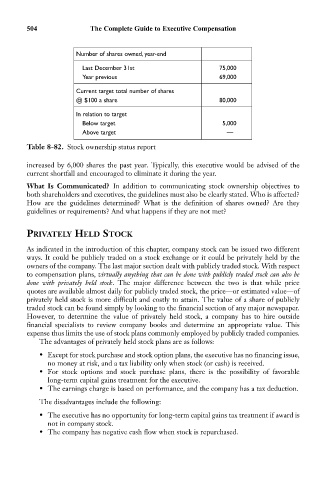Page 518 - Bruce Ellig - The Complete Guide to Executive Compensation (2007)
P. 518
504 The Complete Guide to Executive Compensation
Number of shares owned, year-end
Last December 31st 75,000
Year previous 69,000
Current target total number of shares
@ $100 a share 80,000
In relation to target
Below target 5,000
Above target —
Table 8-82. Stock ownership status report
increased by 6,000 shares the past year. Typically, this executive would be advised of the
current shortfall and encouraged to eliminate it during the year.
What Is Communicated? In addition to communicating stock ownership objectives to
both shareholders and executives, the guidelines must also be clearly stated. Who is affected?
How are the guidelines determined? What is the definition of shares owned? Are they
guidelines or requirements? And what happens if they are not met?
PRIVATELY HELD STOCK
As indicated in the introduction of this chapter, company stock can be issued two different
ways. It could be publicly traded on a stock exchange or it could be privately held by the
owners of the company. The last major section dealt with publicly traded stock. With respect
to compensation plans, virtually anything that can be done with publicly traded stock can also be
done with privately held stock. The major difference between the two is that while price
quotes are available almost daily for publicly traded stock, the price—or estimated value—of
privately held stock is more difficult and costly to attain. The value of a share of publicly
traded stock can be found simply by looking to the financial section of any major newspaper.
However, to determine the value of privately held stock, a company has to hire outside
financial specialists to review company books and determine an appropriate value. This
expense thus limits the use of stock plans commonly employed by publicly traded companies.
The advantages of privately held stock plans are as follows:
• Except for stock purchase and stock option plans, the executive has no financing issue,
no money at risk, and a tax liability only when stock (or cash) is received.
• For stock options and stock purchase plans, there is the possibility of favorable
long-term capital gains treatment for the executive.
• The earnings charge is based on performance, and the company has a tax deduction.
The disadvantages include the following:
• The executive has no opportunity for long-term capital gains tax treatment if award is
not in company stock.
• The company has negative cash flow when stock is repurchased.

